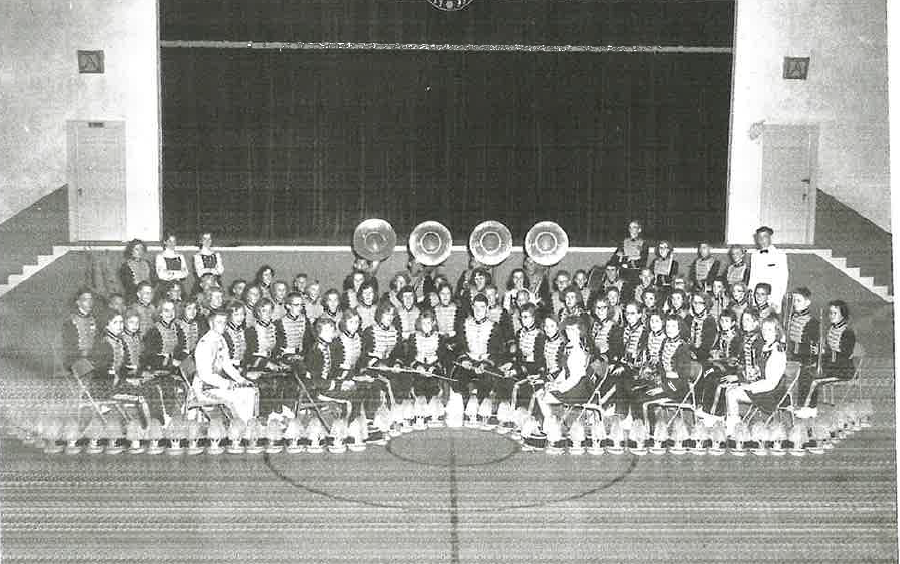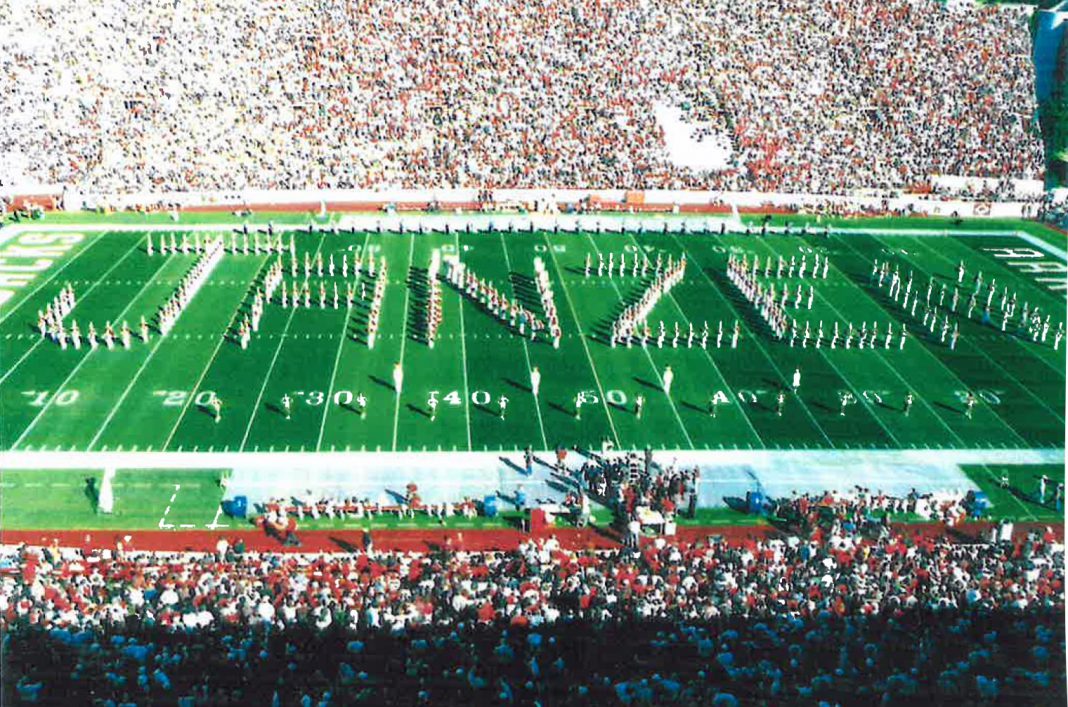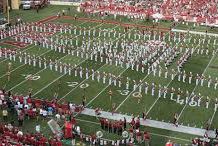Eldon Janzen and The University of Arkansas Band Program

Born March 21, 1928, Janzen grew up in Medford, Oklahoma-about 120 miles north of Oklahoma City and barely 13 miles from the Kansas-Oklahoma state line. He began his music career when Medford’s new band director, Jack Norman, came to Eldon’s sixth-grade classroom to administer a music aptitude exam. Norman was not an instrumentalist. He earned a music degree from Philips University in Enid, Oklahoma as a vocal major. Norman was there to select students for the beginning band program. Norman arrived with Medford’s full inventory of band instruments– a trombone that had become available when the local preacher’s son left town to attend the University of Oklahoma, and an alto clarinet. His friend, John, took the alto clarinet so Eldon selected the trombone. In the eighth grade, he was provided with a new trombone that was purchased with funds raised by a bake sale. While attending Medford High School, Janzen and band director, Delvis B. Roberts, traveled to Chenoweth and Green Music Company in Enid, Oklahoma. Eldon was shocked when Roberts offered him a loan of $108.00 to purchase a reconditioned Conn trombone. He repaid the loan in full by the end of the summer.
Janzen also played a major role in Medford High School’s state championship—not in band, but as a member of Medford’s 1945 football team. Eldon, who played defensive end, receiver, and was also the team’s place kicker, was selected as a member the Oklahoma All-State Football team by Oklahoma sports writers. The 184-pound star for the Medford Cardinals, was invited to play on the north squad in Oklahoma’s annual all-star game. He was eventually offered a full athletic-scholarship to Oklahoma A&M University (now known as Oklahoma State University). Eldon declined the athletic scholarship and opted to accept a less-lucrative scholarship, one that would allow him to pursue a degree in music. Janzen graduated from Oklahoma A&M in 1950 and returned to Medford where he resumed his old job sacking groceries at the grocery store. When Eldon’s former high school football coach informed him that Medford High School was in need of a band director and asked Janzen if he was interested in taking the job. Since band directing sounded better than sacking groceries, Janzen took the job and began his career as a public-school band director at the salary of $200.00 per month.
One year later, Eldon was drafted into the military and sent to the Red River Arsenal at Texarkana for basic training as a rifleman. However, while stationed in temporary barracks and surrounded by eight inches of snowfall, he developed a severe ear infection and was transported to the Army-Navy General Hospital in Hot Springs. The infection caused hearing damage that would continue to be a problem throughout his career. While recuperating in the hospital, Janzen’s unit was deployed to Korea. Upon his release from the hospital, Eldon accepted a part-time position as a church organist. There, he met a young lady by the name of Nelda S. Routon. They began seeing each other regularly and were married on July 7, 1951 in Texarkana.
Janzen was honorably discharged from the military in 1953 and entered North Texas State College, in Denton, Texas (formerly known as North Texas State Teachers College, changed later to North Texas State University, and eventually to The University of North Texas) where he was a graduate assistant to Maurice McAdow. Janzen graduated with his master’s degree in music education in 1953 and accepted an offer to be the band director at New Boston High School where he served from 1954-1959. From New Boston, Eldon served as band director at Greenville High School from 1959 – 1962, and then to Irving, Texas where he served as the band director at Irving High School from 1962 – 1966 and the district’s director of fine arts from 1967 – 1970.
It’s always good to hear positive comments from band members, parents, fans, especially after having a cross burned in your front yard. But when you receive accolades from your colleagues at other universities, that’s when you know that people, trained musicians and experienced educators are taking notice. One such instant took place in Dallas when Arkansas was playing SMU in the Cotton Bowl. Irving Dreibrodt, the director of the SMU Mustang Band, fielded what was known as “96 Guys and a Doll,” which referred to the 96 male band members and their feature twirler. During those days, when there was a visiting college band attending the game, Dreibrodt, or “Dry” as his closest friends and colleagues called him, would invite a local high school band director up to the press box to view both bands at halftime. When both bands had completed their shows, Dreibrodt would then ask the visiting high school band director to tell him which college band was best.
At that time, the band director at Highland Park was Bob Jordan and Bob had really put the Highland Park band program on the map. You can hear the satisfaction in Janzen’s voice as he describes the event:
We performed a show called The Ladies of Spain. We played the Lady of Spain and some other Spanish tunes while marching circles and power drills. And it was really good. Bob told me later that, after both bands performed, Dry asked him, ‘Well, Jordan, what do you think?’ And Bob said, ‘Dry–you just got waxed.’
As our interviews concluded, I asked Mr. Janzen to comment on a topic that held special meaning or significant to him professionally. He recalled the year his Irving High School Symphonic Band performed at the Texas Music Educators Association Convention. In 1965, TMEA was held at the Adolphus Hotel in Dallas.
“Fred Fennell and I were good friends, although he could never remember my name. In 1964, Bryce Taylor called me and said that Fennell would be conducting the TMEA All-State band and he thought it would be a good opportunity to have him present a lecture explaining the difference between the symphonic band and the wind ensemble. Bryce said that he had called Joe Frank Sr. who told him that we were working on two pieces that Fennell would like to use-Elsa’s Procession to the Cathedral and Lincolnshire Posy. So I said, ‘sure!’
When we arrived at the hotel for the performance, I noticed that the chairs had been placed in very close proximity to the students. The feeling in Texas at that time was not very sympathetic towards the wind ensemble concept so the event attracted a capacity crowd of band directors who quickly filled the room, taking all the chairs in the process. Even after the room was filled, people continued to enter. Additional chairs were brought in and placed so close to the students that they were able to look over their shoulders during the performance. The students were scared to death.
When time came for the performance to begin, Fennell entered and Bryce Taylor, from Alice High School, introduced the ensemble and explained the purpose of the clinic. Fennell began by explaining that he never intended to be the source of controversy and that the wind ensemble concept was simply a something that came about while flat on his back with hepatitis for six months. Prior to his illness, he conducted a large symphonic band and Eastman. After his recovery, he decided to pursue the wind ensemble ideas that had occupied his mind during his illness. This led to the famous British Band Classic recordings that exploded in popularity in Texas. With that explanation, Fennell began the performance by conducting Elsa’s Procession to the Cathedral with Janzen’s Irving High School Symphonic Band.
My Irving High School Symphonic band was typical for bands at that time. We had about 96 student members, a 21-person clarinet section, and all that. Fennell made a few corrections and some comments regarding phrasing and then he performed the piece all the way through without stopping. When he stepped down from the podium, he said, “Well, what can I say?” Everyone was already standing and they gave him a big ovation.
After the performance of Elsa’s Procession to the Cathedral, Fennell excused about half of the band members leaving the remainder in place to serve as a demonstration group. Janzen still has letter indicating the exact instrumentation that Fennell wanted for the demonstration. Janzen states, “he wanted a twenty-six piece wind ensemble. It was this event that put the Irving band on the map. And Fennell always remembered me, but could never in my name. He always referred to me as, “that guy from Texas.
How Bands Have Changed Over the Years

I have a serious disagreement with how many bands sound today. The traditional symphonic band sound no longer exists because most college bands have adopted the wind ensemble concept. As a result, student musicians come through college with that sound in their mind and many begin their teaching career with the view of the symphonic sound as being “obsolete” or, in one way or another, inferior to the wind ensemble sound.
To my ear in the wind ensemble setting– if you get students who can play the part–that’s it! There isn’t as much focus on the blending of sounds or balance within section or between sections…woodwind, brass, and percussion. I once asked the eminent Frederick Fennell if he ever asked his players to adjust the kind (bright, dark, shaded, piercing, etc) of sound they were producing. He replied “absolutely never” which shocked me, but after years of contemplation, that is, indeed, a characteristic of many wind ensembles. He would certainly not have difficulty at Eastman finding talented students.
I just recently found an article that Jim Nelson wrote for CBDNA. He did a study of the instrumentation of the concert band, and in conclusion, his recommendation; this in many ways defined the concert band instrumentation. He also felt the brass section should speak freely and without regard to over powering the woodwinds.
It was Joseph Frank who brought his version of the symphonic band from “the Valley” in Texas; Joe frequently mentioned Robert Vesetti and the Brownsville Band as achieving an “organ-like” quality in defining the symphonic band. It was Fredrick Fennel who touted my Irving School symphonic band during the clinic in which he illustrated the differences between the Wind ensemble and symphonic band. I felt his approval validated my opinion.
Reading words from someone who started his teaching career in 1949 becomes a risk of being branded as “out of touch” with the profession, but at worst being branded “an old fogey” is a risk I can endure. My “old saw” concerns the changing concept of what was originally referred to as a “concert band”. It was as long ago as 1960 that James Nielsen took the charge of the College Band Directors Association to research and report the “standard instrumentation” of a concert band. The resulting information was used by music publishers to base the sale of printed parts for a full band arrangement for many years.
… and alas, almost overnight the grand lush sound of the Symphonic Band who wanted to compete with the symphony orchestra, faded into the sunset.
–Eldon Janzen, September 5, 2018






